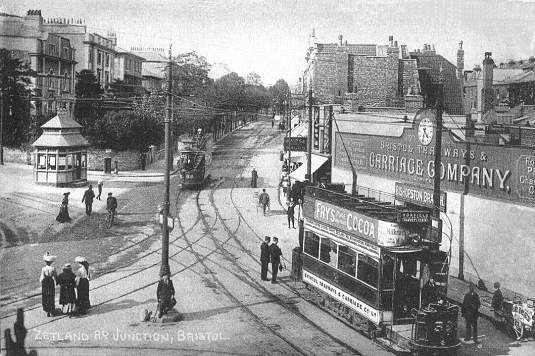

Our card is at the Zetland Road junction north of Bristol city centre showing car 59 in the foreground going down Cheltenham Road to the "Tramways Centre". In the background, car 68 is on its way up Gloucester Road towards Horfield. The route along the Zetland Road, down to the left, goes via Redland Road to Durdham Downs. Is that a points-man (or 'points-boy') sitting at the traction pole in the foreground? He appears to have a point iron in his hand. Note on the right the buildings of the Bristol Tramways & Carriage Company's Bishopston Branch, a bus garage and offices. The card is from an unknown publisher and dates from around 1910.
The first horse trams in Bristol were operated by the Bristol Tramways Company from 9th August 1875. There was a brief flirtation with steam trams on the steep Horfield route in 1880. In 1887 the company merged with the Bristol Cab Company and, on receiving its new title, operated all manner of horse drawn vehicles with 20 miles of horse tramway running 103 trams. It soon became part of the Bristol based Imperial Tramways Group under the Chairmanship of James Clifton Robinson and the backing of Sir George White. The first electric trams ran on 14th October 1895 from Old Market to Kingswood. Over the next few years the electric system expanded to some 31 route miles in 1908 operated by 237 trams, all open-top double-deck (also a few horse cars were used as trailers).
Both the trams in our picture were part of a batch of 85 standard gauge cars built by Milnes in 1900/1 with 24 seats inside and 29 on top. They were mounted on Peckham Cantilever 4-wheel trucks having two 28 horse-power GE 58-6T motors and BTH B3 controllers. The livery was ultramarine blue and cream.
The Bristol Company went on to build buses for many operators and operate a large fleet themselves. In 1910 craftsmen from their Brislington tram works were transferred to a new works at Filton to build racing biplanes as the Bristol Aeroplane Company - now British Aerospace. However, the future of Bristol tramways was not so long lived. Under the terms of the 1870 Tramways Act, local councils had the right to purchase tramways in their areas 21 years after construction and every seven years thereafter. It was this threat over many years that lead Bristol (and many other companies) not to modernise its open top fleet. In 1937 the Corporation did make its purchase, but in the event the company remained the operator. From 1938 trams began to be replaced by buses. By April 1941 only the Kingswood and Hanham routes remained when, on the 11th of that month, a German bombing raid damaged Brislington depot and demolished St. Philips Bridge, cutting the power supply cables from the generating station. Trams never ran again and remaining cars had to be towed to Kingswood for scrapping bringing Bristol's tramway to a somewhat sad end.
![]() Go to Postcard Of The Month Index
Go to Postcard Of The Month Index